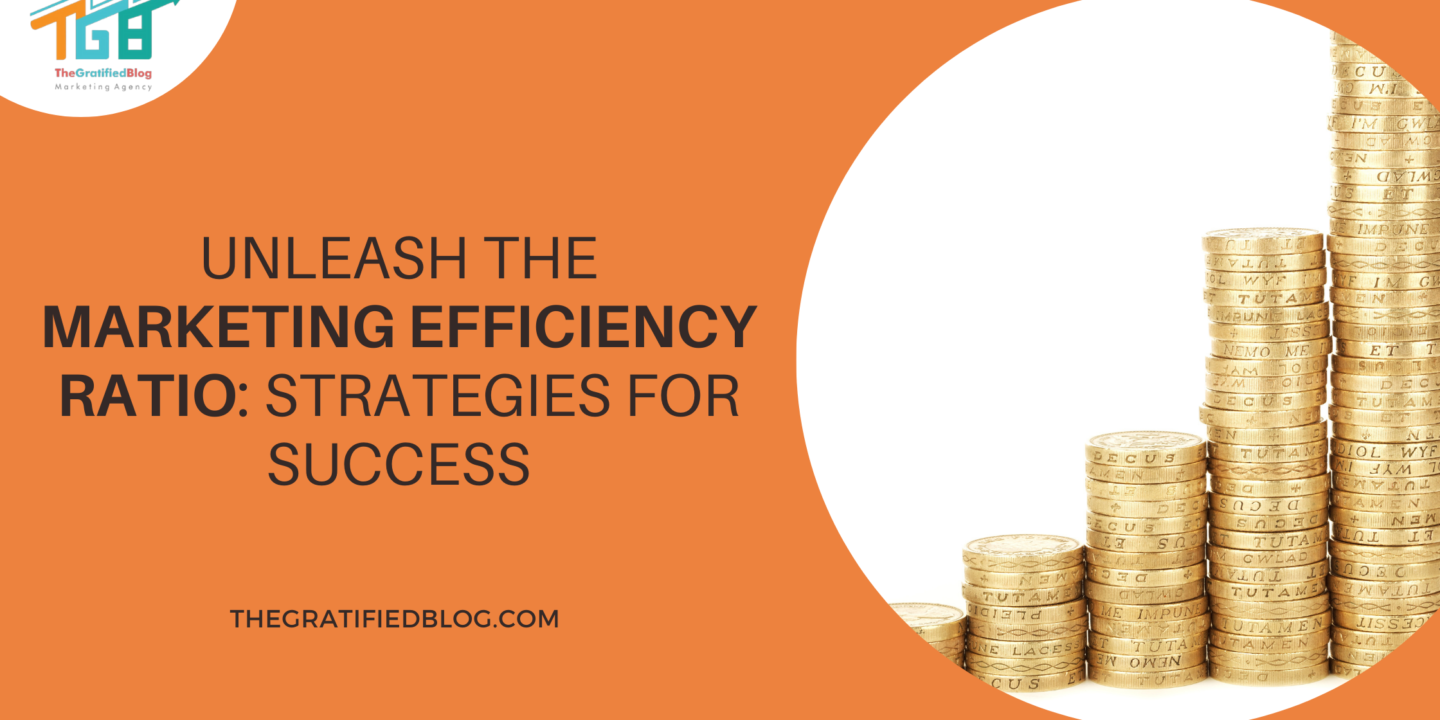
In the dynamic landscape of modern business, where every marketing dollar spent must translate into tangible returns, the marketing efficiency ratio has emerged as a critical metric for success. This metric encapsulates the relationship between marketing investments and revenue generation, offering businesses a clear and quantifiable measure of their marketing effectiveness.
In this blog, we delve into the intricacies of the marketing efficiency ratio, exploring its definition, calculation methods, importance, and practical strategies for improvement.
Join us as we unravel the secrets to unlocking maximum value from your marketing efforts and achieving optimal ROI in today’s competitive marketplace.
So, let’s get started:
What Is A Marketing Efficiency Ratio?
The marketing efficiency ratio is a key performance indicator (KPI) used to assess the effectiveness and productivity of marketing efforts within a business. It measures the relationship between the revenue generated from marketing activities and the cost incurred to execute those activities.
The marketing efficiency ratio quantifies how efficiently a company’s marketing investments convert into revenue.
Calculating The Marketing Efficiency Ratio
The marketing efficiency ratio is calculated using the following formula:
Marketing Efficiency Ratio=Revenue Generated from Marketing/Cost of Marketing
Importance of each component in the formula:
- Revenue generated from marketing efforts: The revenue generated from marketing efforts is crucial to the marketing efficiency ratio. It represents the monetary outcome directly attributed to the company’s marketing activities. This revenue can include sales generated from marketing campaigns, leads converted into customers, or any other measurable impact on revenue resulting from marketing efforts.
- Cost of marketing activities: The cost encompasses all expenses incurred in executing marketing strategies and campaigns. This includes costs related to advertising, promotions, content creation, marketing technology, personnel, and any other investments made to support marketing initiatives. Understanding and accurately accounting for these costs are essential for evaluating the efficiency of marketing spend.
- Timeframe for measurement: The measurement timeframe is another critical aspect of calculating the marketing efficiency ratio. It determines the period over which revenue and costs are considered, providing context and relevance to the ratio. The timeframe can vary based on business objectives, campaign duration, reporting cycles, and the need for short-term or long-term performance analysis. Choosing an appropriate timeframe ensures the ratio reflects current marketing effectiveness and helps make timely strategic decisions.
Now that we’ve covered the marketing efficiency ratio and its calculation let’s delve into its advantages and challenges.
Understanding The Benefits And Challenges Of Measuring Marketing Efficiency Ratio
Benefits Of Measuring Marketing Efficiency Ratio
- Improved allocation of resources: Businesses can identify which marketing channels, campaigns, or strategies deliver the best results by measuring marketing efficiency. This insight allows for the reallocation of resources towards high-performing activities, maximising the impact of marketing investments and reducing wasteful spending on less effective initiatives.
- Better decision-making and strategy development: Data-driven insights from measuring marketing efficiency enable informed decision-making and strategic planning. Businesses can analyse performance metrics, identify trends, and adjust real-time strategies to align with market dynamics and consumer behaviour. This proactive approach leads to more effective marketing campaigns and a competitive edge in reaching target audiences.
- Enhanced ROI and profitability: Measuring marketing efficiency directly correlates to calculating return on investment (ROI) from marketing activities. Businesses can improve profitability by optimising efficiency and focusing resources on activities with high ROI. This includes maximising revenue generation, reducing costs, and positively impacting the bottom line.
- Competitive advantage in the market: A strong marketing efficiency strategy gives businesses a competitive advantage by enabling them to deliver more targeted, personalised, and impactful marketing messages. This results in higher brand recognition and more engaged customers. Loyalty is a stronger position relative to competitors who may prioritise marketing efficiency to a different extent.
Challenges And Limitations
- Data accuracy and reliability: Ensuring the accuracy and reliability of data used to calculate the marketing efficiency ratio can be challenging. Issues such as incomplete data, data discrepancies, and data collection or processing errors can skew results and lead to inaccurate assessments of marketing performance.
- Attribution and tracking across multiple channels: Tracking and attributing marketing outcomes across various channels (e.g., online and offline, digital and traditional) can be complex. Challenges arise in accurately attributing conversions and revenue to specific marketing touchpoints or campaigns, especially in omnichannel environments where customer journeys are interconnected and span various platforms.
- Balancing short-term results with long-term brand building: Marketing efforts often balance short-term results (e.g., immediate sales or leads) and long-term brand building (e.g., brand awareness, reputation, customer loyalty). Measuring marketing efficiency may prioritise short-term metrics, potentially overlooking the value of long-term brand equity and customer lifetime value, which are essential for sustainable growth.
Having discussed the benefits and challenges of the marketing efficiency ratio, let’s explore strategies for enhancing it.
Strategies For Improving Marketing Efficiency Ratio

Use of analytics and marketing automation tools:
Leveraging analytics tools allows businesses to gather, analyze, and derive actionable insights from vast marketing data. These tools provide visibility into key performance indicators (KPIs), customer behaviour, campaign performance, and ROI metrics.
By harnessing data-driven insights, businesses can make informed decisions, optimize real-time marketing strategies, and allocate resources more effectively. Additionally, incorporating marketing automation tools streamlines repetitive tasks, enhances workflow efficiency, and enables personalized communication with customers at scale.
Automation tools can manage email marketing, social media scheduling, lead nurturing, and campaign tracking, Enabling marketers to dedicate their time to strategic planning and creative endeavours.
Regular monitoring and optimisation of campaigns:
Continuous monitoring and optimisation of marketing campaigns are essential for maximising efficiency and performance. This involves setting clear objectives and KPIs, tracking campaign metrics, analysing results, and making data-driven adjustments.
Marketers should conduct A/B testing, experiment with different messaging, creative elements, and targeting strategies, and iterate based on performance insights. By closely monitoring campaign performance in real-time, marketers can identify underperforming areas, seize opportunities for improvement, and optimise campaigns for better outcomes.
Regular optimisation ensures marketing efforts align with business goals, customer preferences, and market trends, driving continuous improvement and ROI.
Collaboration between marketing and finance teams:
Collaboration between marketing and finance teams fosters alignment, transparency, and accountability in measuring and optimising marketing efficiency. Marketers can work closely with finance professionals to establish clear budgetary goals, track marketing spend, and evaluate ROI across different marketing initiatives.
Finance teams can provide valuable insights into cost management, profitability analysis, and financial forecasting, enabling marketers to make data-driven decisions and prioritise investments based on economic performance.
Cross-functional collaboration ensures that marketing strategies align with overall business objectives, financial constraints, and long-term growth targets, driving greater accountability and strategic alignment.
Customer-centric approach and personalisation:
Adopting a customer-centric approach and leveraging personalisation techniques are critical strategies for improving marketing efficiency. By understanding customer needs, preferences, and behaviours, marketers can create tailored experiences, targeted messaging, and relevant offers that resonate with their audience.
Personalisation can be achieved through segmentation, dynamic content, personalised recommendations, and personalised communications across multiple channels. By delivering personalised experiences, businesses can enhance customer engagement, increase conversion rates, foster brand loyalty, and maximise ROI.
A customer-centric approach ensures that marketing efforts are focused on delivering value to customers, building meaningful relationships, and driving long-term customer satisfaction and loyalty.
Conclusion
Having gained insights into the marketing efficiency ratio, it’s evident that this metric is crucial in guiding businesses towards more intelligent resource allocation, improved decision-making, and enhanced profitability. By understanding and optimising the marketing efficiency ratio, companies can maximise their ROI, Attain a competitive edge and foster sustainable expansion in the ever-evolving contemporary business environment.
However, if you still have any questions related to the blog, please leave them in the comment section below. We will be happy to answer them.
Thanks for reading 🙂








No Comments